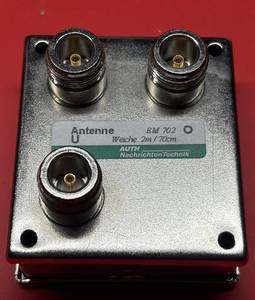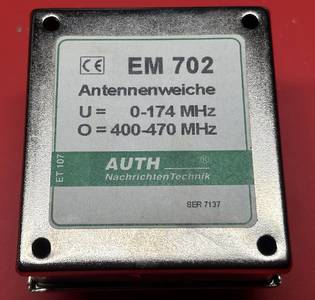Some quick measurements on a DK2DB balun.
It is a W1JR-style wound balun with a AMIDON 140-43 FT core.
Also check the measurements on a flea market find BALUN.
Some quick measurements on a DK2DB balun.
It is a W1JR-style wound balun with a AMIDON 140-43 FT core.
Also check the measurements on a flea market find BALUN.
Some quick measurements on a flea market find BALUN with a WÜRTH-core 7427015 7427015
Also check the measurements on a DK2DB-style balun
The HM-243 speaker/microphone combo supplied with the ICOM IC-705 is rather bulky, making it difficult to transport and operate. It has a thick, curled cable and must be connected to the side of the IC-705 with two jack plugs.
Inspired by a newsletter from WIMO.COM I tried the Bluetooth speaker/microphone combo BHM-79 from VERO TELECOM. At just 120g, the BHM-79 is an extremely lightweight speaker/microphone.
I have some stuff for sale. Please contact me by Diese E-Mail-Adresse ist vor Spambots geschützt! Zur Anzeige muss JavaScript eingeschaltet sein! if you're interested. Prices are negotiable.
tbd
I ordered some days ago a new ZachTek WSPR desktop transmitter for some field tests. This transmitter is powered by 5VDC via a simple USB cable.
As an avid reader of Tom's K4SWL Blog I've seen HAMs using many times a small powerbank from Talentcell - the YB1203000-USB - which is advertised as a 12V 3.000mAh powerbank.
As can be seen on their website, that the powerbank uses three 18650 LiIon cells. The regular voltage of an LiIon battery is 3.6V - three cells will give 10.8V and not 12V?!
Initally with not further searching on the internet, I ordered the powerbank on eBay, as the specs looked fine on first glance :-/
I bought one of the last kits from WA3RNC ... more to come ...
My Mosquita got a new housing as described in this post. As you can see, there is still enough room for a memory morse keyer.
For my POTA / SOTA activities I searched for a better 2m/70cm antenna for my ICOM ID-52+ compared to the stock antenna.
I've seen many operators using the Diamond RH770 telescopic antenna and I gave it a try:
I borrowed a 2m / 70cm diplexer from a fellow HAM to connect my Multiband-2m/70cm-Antenna to my IC-9700. The IC-9700 has a 2m and a separate 70cm port - the antenna a single port - thats why I need the diplexer. 

The diplexer is a german manufactured AUTH EM 702.
Andreas has already implemented a computer interface for the ICOM CI-V protocol for his antenna tuner.
I have built a Bluetooth interface into my tuner so that you can control the tuner very conveniently via the ICOM IC-705.
I've done some measurements on my KH1 (Serno 00845 FW 1.25)
Meter - SIGLENT SSA3021X
40dB PAD - Weinschel 58-40-33
Some times ago, I found for me a solution, how to handle the unstable readings from the ADC. I've described it in this post.
In the meantime, some HAMs also build the RF powermeter based on the work of Makis, SV1AFN and myself. One if these HAMs, PA3AXA Rens, digged a little bit deeper and analysed the problem in detail. Here his description.
A hint from the German HAM Jens, DL1LEP points to the another solution:
Instead of adding a pull-down or series resistor to the CS line, use a pull-up resistor to +5VDC with 5-10kOhm
Some weeks ago I've build a full-featured XPhase for my father, DK1UO. He is sometimes affected by heavy interference from Plasma-TVs or similar scrap
The function of the XPhase is based on the fact that the interfering signal, received by an auxiliary antenna, is added phase-shifted to the signal received from the main antenna. When the phase-shift is more or less 180°, the interfering signal is canceled out.
My XPhase is based on the work of Hanns, DK9NL. A commercial versions can be found here under the name QRM-Eliminator. Google will provide you some futher informations.
I wanted to make something again :-)
The result is a symmetrical antenna tuner for KW up to max. 20W. Further details can be found at the inventors web-site, Andreas, DL4JAL:
Andreas' preparations are great - the whole circuit worked straight away. At the beginning I thought - uuuuh soldering this much chicken feed - with good solder, lots of light and a head magnifier I managed it quite well.
Now the tuner is ready for its first field use on a symmetrical dipole - I'll report back.
A small SWR-Simulator for QRP tests. This tiny unit provides SWR values of 1:1, 2:1 and 3:1.
My new TR-35 QRP CW transceiver does not have a build-in tuner nor a build-SWR meter. My search for a very small and simple metering solution led me to the work of Martin, DK3IT.
His complete work can be found on GITHUB for download. As suggested on his site, I've ordered three tiny PCBs via OSHPARK - unbelievable that you can three PCBs including shipment to DL for €2,22.
Inspired from the work of EA4TX and K3NG I decided to check, whether the ESP8266 based NodeMCU 1.0 (ESP-12E) is usable as a simple remote IP-based rotator control. You can get the NodeMCU in a decent quality on eBay.
Idea was, to link a local emulated serial port to the NodeMCU module. The HAM Radio applications are communicating via the standard Yaesu GS232A protocol with the emulated serial port. This emulated serial port then forwards the serial requests to the NodeMCU.
I try to fix a HARDROCK-50 amplifier, which a fellow HAM bought second hand but it didn't really work.
Ich habe die Firmware für die Hamware Tuner um den Yaesu FT-991A erweitert.
In Verbindung mit den Logbuchprogrammen UCXLog und Swisslog folgt der Tuner automatisch der eingestellten Frequenz.
Nähere Infos sind hier zu finden.
I've developed a small interface board for the HAMWARe controller AT-502, AT-515 and AT-651B. This interface boards supports RS232 and CI-V communications and can be directly mounted into the controller chassis.